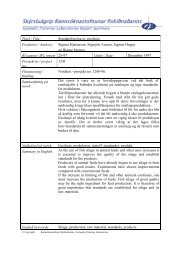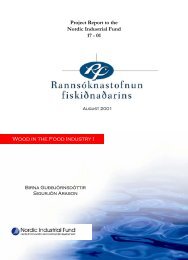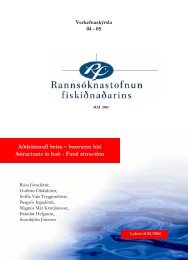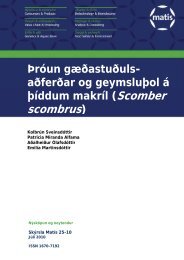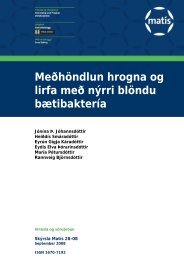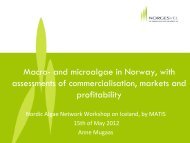Microbiology and Spoilage Trail in Nile Perch (Lates niloticus), Lake ...
Microbiology and Spoilage Trail in Nile Perch (Lates niloticus), Lake ...
Microbiology and Spoilage Trail in Nile Perch (Lates niloticus), Lake ...
You also want an ePaper? Increase the reach of your titles
YUMPU automatically turns print PDFs into web optimized ePapers that Google loves.
eservoir i.e. Salmonella, Shigella, E. coli, <strong>and</strong> Staphylococcus aureus, (Huss, Dalgaard <strong>and</strong><br />
Gram, 1997).<br />
Generally fish <strong>and</strong> shellfish are common vehicles of transmitt<strong>in</strong>g food borne diseases. On<br />
the other h<strong>and</strong>, pathogenic bacteria (<strong>in</strong>digenous bacteria) represent part of the natural flora<br />
on particularly fish from coast <strong>and</strong> estuar<strong>in</strong>e environment. Accord<strong>in</strong>g to Huss, Dalgaard <strong>and</strong><br />
Gram, (1997), the <strong>in</strong>digenous (pathogenic) bacteria <strong>in</strong>clude Vibrio spp., C. botul<strong>in</strong>um (Type<br />
E), L. monocytogenes, Aeromonas spp., <strong>and</strong> Shewanella alga. However, the level of<br />
contam<strong>in</strong>ation is normally quite low <strong>and</strong> it is unlikely that the numbers which are naturally<br />
present <strong>in</strong> uncooked seafood are sufficient to cause disease <strong>in</strong> healthy human be<strong>in</strong>g. Hence<br />
fish as food has far better record on safety than the mammalian meat.<br />
It is known that the primary source of cholera is feces of <strong>in</strong>fected persons <strong>and</strong> transmission<br />
of bacteria with water <strong>and</strong> food. However, at present it has also been found that <strong>in</strong> certa<strong>in</strong><br />
areas the aquatic environment is a natural reservoir (habitat) for Vibrio cholerae 01. This<br />
means that seafood may be contam<strong>in</strong>ated even if harvested <strong>in</strong> unpolluted waters, (Popovic<br />
et al., (1993), Huss, Dalgaard <strong>and</strong> Gram, 1997). Aeromonas spp. that is pathogenic to both<br />
fish <strong>and</strong> human can be present <strong>in</strong> aquatic environment, on fish or even <strong>in</strong> tap (dr<strong>in</strong>k<strong>in</strong>g)<br />
water (Gibson, 1992). The microbiologists have been tak<strong>in</strong>g the criteria to account that the<br />
presence of Escherichia coli <strong>in</strong> food <strong>in</strong>dicates the probability of contam<strong>in</strong>ation of the food<br />
products with the sewage of human or animal orig<strong>in</strong>. Consequently it has been referred as<br />
an <strong>in</strong>dicator for the presence of pathogenic <strong>in</strong>test<strong>in</strong>al bacteria. On the other h<strong>and</strong>, certa<strong>in</strong> E.<br />
coli stra<strong>in</strong>s (EnteropathogenicEPEC; Entero<strong>in</strong>vasive-EIEC; Enterotoxigenic-ETEC; <strong>and</strong><br />
Enterohaemorrhagic-EHEC) are pathogenic <strong>and</strong> lead to serious human diseases that can<br />
betransmitted with water <strong>and</strong> food (Doyle, 1990).<br />
The faecal coliforms <strong>and</strong> E. coli are particularly useful as <strong>in</strong>dicators of faecal contam<strong>in</strong>ation<br />
<strong>and</strong> poor h<strong>and</strong>l<strong>in</strong>g of seafood’s. This is because the organisms are absent from the fish at<br />
the time of capture except <strong>in</strong> grossly polluted waters. The aerobic plate counts (APC) or<br />
total viable count (TPC) is recommended for all fish <strong>and</strong> fish products because of its<br />
usefulness as an <strong>in</strong>dicator of utility, the condition <strong>and</strong> length of storage of products prior<br />
preservation processes such as freez<strong>in</strong>g. Accord<strong>in</strong>g to ICMSF, (1986), most aquatic animals<br />
at the time of harvest have counts <strong>in</strong> the region of 10 2 – 10 5 organisms per gram. While an<br />
<strong>in</strong>crease <strong>in</strong> APC/TVC to levels >10 6 per gram is an <strong>in</strong>dicative of long storage at chill<br />
8




